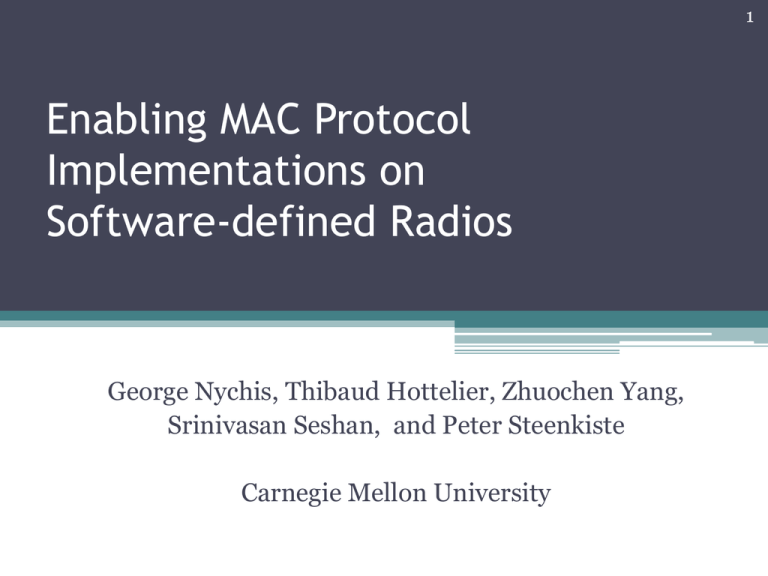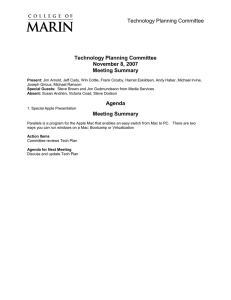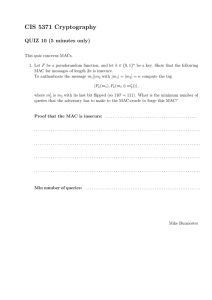Enabling MAC Protocol Implementations on Software-defined Radios
advertisement

1 Enabling MAC Protocol Implementations on Software-defined Radios George Nychis, Thibaud Hottelier, Zhuochen Yang, Srinivasan Seshan, and Peter Steenkiste Carnegie Mellon University 2 Wireless Media Access Control Protocols • No single one-size-fits-all MAC ▫ definition of performance, and how to achieve it, varies greatly • Wireless MACs: extremely diverse ▫ long-haul, mesh, lossy, dense, mobile … • Novel fundamental wireless optimizations: ▫ MIXIT, PPR, Successive IC, ZigZag, … How can we easily implement diverse MAC protocols and optimizations? 3 Current MAC Protocol Development Wireless NICs High Performance (DSP) Low cost ($30) Closed source ▫ most of the MAC Fixed functionality: ▫ Physical layer, 2.4GHz Software Radios Various open source platforms Fully reprogrammable ▫ and various frequencies! Higher cost ($700-$10K) Lower performance (GPP) ▫ large delays 4 Implementing MACs on SDRs • Various projects using SDRs for evaluation: ▫ MIXIT, PPR, Successive IC, ZigZag … • The above all use GNU Radio + USRP: ▫ “extreme” SDR all processing in userspace ▫ great as a research platform (PHY+MAC) • No high-performance MAC protocol implemented on GNU Radio & USRP 5 Outline of the Talk • Why MAC implementation on SDRs is challenging • How to overcome SDR limitations, enabling highperformance and flexible MAC implementations ▫ A novel approach: Split-functionality API • Present evaluation of the first high-performance MACs on an extreme architecture • Implications and Conclusions 6 “Extreme” SDR Architecture 802.11 <10μs SIFS DIFS ACK-TO 10μs 28μs 22μs 25μs 1ms Kernel CS Userspace Medium Antenna Front End negligible Simply packing the 25μs 15ns too samples takes long for an ACK! 120μs Bus (USB) ADC + + FPGA DAC Modulation, Framing 7 Solutions to Bypass Delay • Common: move the layers closer to the frontend ▫ WARP: PHY+MAC on the radio hardware ▫ SORA: PHY+MAC in kernel, core ded., SIMD, LUT • Completely viable solutions, but: ▫ ▫ ▫ ▫ costly (hardware is more complex, WARP: $10K+) can require special toolkits (e.g., XPS) requires embedded architecture knowledge portability and interface (SIMD, PCI-E) 8 An Alternate Solution • Split-functionality approach, break all core MAC functions (e.g., carrier sense) in to 2 pieces: ▫ 1 small piece on the radio hardware (performance) ▫ 1 piece on the host (flexibility) • Then, develop an API for the core functions ▫ logical control channel and per-block metadata ▫ per-packet control of the functions & hardware ▫ applicable to other SDR architectures 9 Indentifying the Core MAC Functions Random Backoff Power Control ▫ carrier sense SIFS/DIFS ▫ precision scheduling ACK ▫ backoff Synchronization ▫ fast-packet detection MIMO ▫ dependent packet generation Frequency Hop ▫ fine-grained radio control Guard Periods Slot Times • Difficult to claim that any list is correct and complete Rate Adaptation ▫ reasonable first “toolbox” Beacons Carrier Sense • Building blocks of MAC protocols: 10 Precision Scheduling • Split-functionality API approach: ▫ Scheduling on the host (flexibility) ▫ Triggering on the hardware (performance) ▫ requires a lead time that varies based on architecture clock Data + Timestamp =? clock Radio Hardware Host Machine FPGA samples/bits/packet Bus (USB) 11 Precision Scheduling • Split-functionality API approach: ▫ Scheduling on the host (flexibility) ▫ Triggering on the hardware (performance) ▫ requires a lead time that varies based on architecture • Average measured error in TX scheduling using GNU Radio and USRP: Precision Split-func. Kernel Host 125ns 35μs 1ms 12 Revisiting the Core MAC Functions • Building blocks of MAC protocols: ▫ ▫ ▫ ▫ ▫ ▫ carrier sense precision scheduling backoff fast-packet detection dependent packet generation fine-grained radio control • Difficult to claim that any list is correct and complete ▫ reasonable first “toolbox” 13 Fast-Packet Detection • Goal: accurately detect packets in the hardware • The longer it takes to detect a packet, the longer a response packet takes (dependent packet) ▫ Can be used to trigger pre-modulated DPs (ACKs) • Demodulate only when necessary (CPU intensive) ▫ provides host confidence of a packet in the stream ▫ not only detect a packet, but that it is for this radio • Can be used in other architectures: ▫ SORA: used to trigger core dedication ▫ Kansas SDR: battery powered, reduces consumption 14 Fast-Packet Detection in Hardware • Perform signal detection using a matched filter ▫ ▫ ▫ ▫ optimal linear filter for maximizing SNR widely used technique in communications flexible to all modulation schemes cross-correlation of unknown & known signals Incoming sample stream Modulated framing bits 15 Packet Detection Host Setup Modulator (GMSK) x[t] Framing Bits 01100110101 + t known signal Host 16 Packet Detection in Hardware Radio Hardware (RX) Matched Filter unknown smpls + known corr. Trigger Yes No FPGA + Host 17 Fast Packet Detection Accuracy • Simulation: detect 1000 data packets destined to the host in varying noise using GMSK and the mfilter • Confirmed in real world (in paper) • 100% accuracy detecting frames • <.5% false detections (i.e., falsely claiming an incoming packet) 18 Revisiting the Core MAC Functions • Building blocks of MAC protocols: ▫ ▫ ▫ ▫ ▫ ▫ carrier sense precision scheduling backoff fast-packet detection dependent packet generation fine-grained radio control … details in the paper! 19 Putting it all together… • Core MAC functions and the split-functionality API implemented on GNU Radio & USRP • “The proof is in the pudding” – we implement two popular MACs ▫ 802.11-like and Bluetooth-like protocols ▫ shows ability in keeping flexibility ▫ used to evaluate total performance gain 20 CSMA 802.11-like Protocol • Uses the following core functions: ▫ Carrier sense, backoff, fast-packet recognition, and dependent packets • Compare host based-implementation to splitfunctionality implementation ▫ host implements everything in GNU Radio (GPP) • Cannot interoperate with 802.11 due to limitations of the USRP, but possible with USRP2 21 802.11-like Protocol Evaluation • USRP (SDR board) configuration: ▫ Target bitrate of 500Kbps ▫ Use 2.485GHz, avoid 802.11 interference ▫ Ten transfers of 1MB files between pairs of nodes 22 TDMA Bluetooth-like Protocol Design • TDMA-based protocol like Bluetooth: ▫ Construct piconet consisting of a master & slaves ▫ Slaves synchronize to a master’s beacon frame ▫ 650µs slot times • Compare split-functionality to host-based again • Bluetooth-like since the USRP cannot frequency hop at Bluetooth’s rate 23 Bluetooth-like Protocol Evaluation • USRP: target bitrate of 500Kbps • Perform ten 100KB file xfers • Vary number of slaves • Vary guard time (needed to account for scheduling error) 24 Conclusions • The API developed enables a split-functionality approach: ▫ maintains flexibility & performance ▫ aspects applicable to other architectures • Identified core MAC functions suitable as a first “toolbox” that can be extended • First to implement high-performance MACs on an extreme SDR such as GNU Radio & USRP


